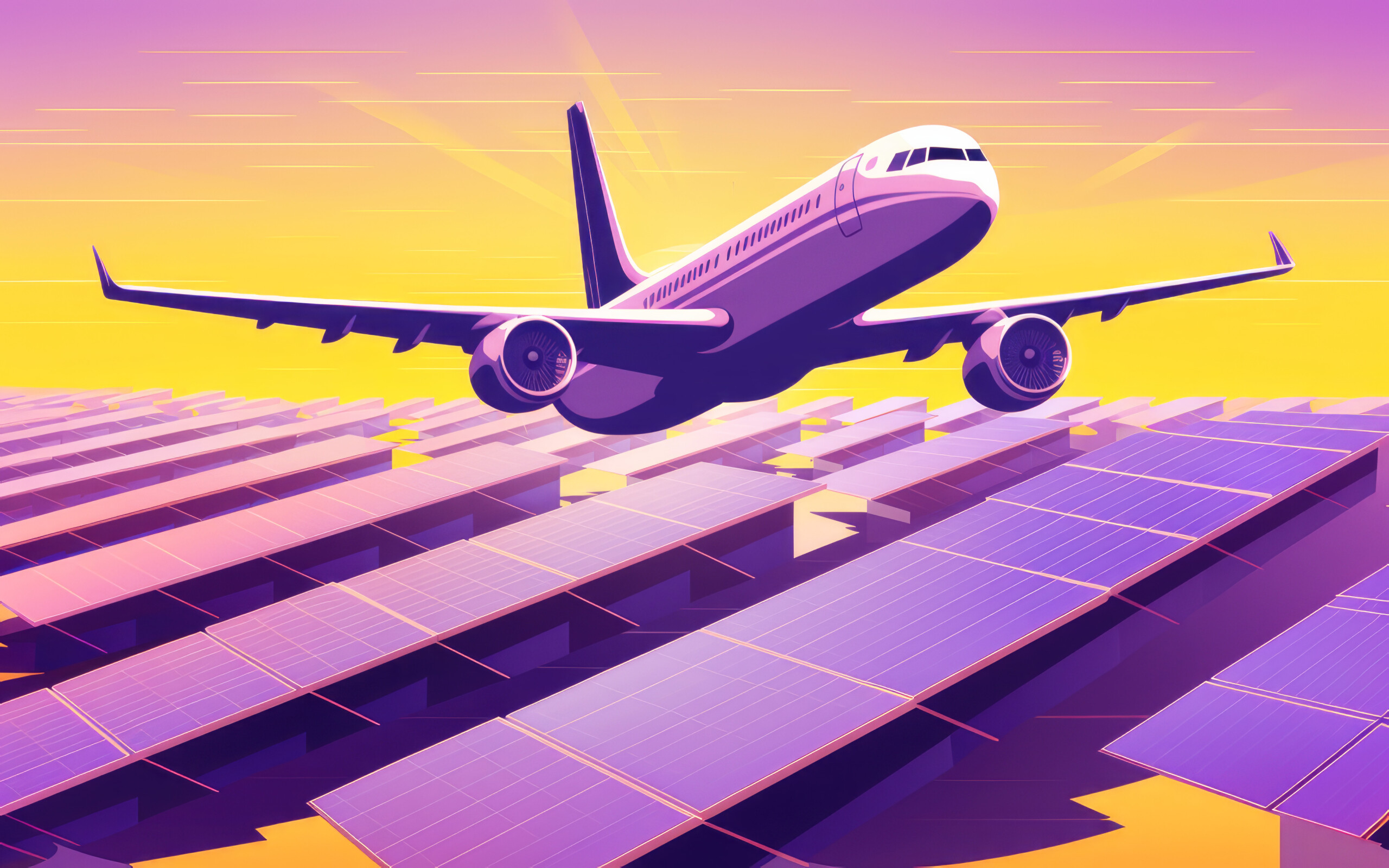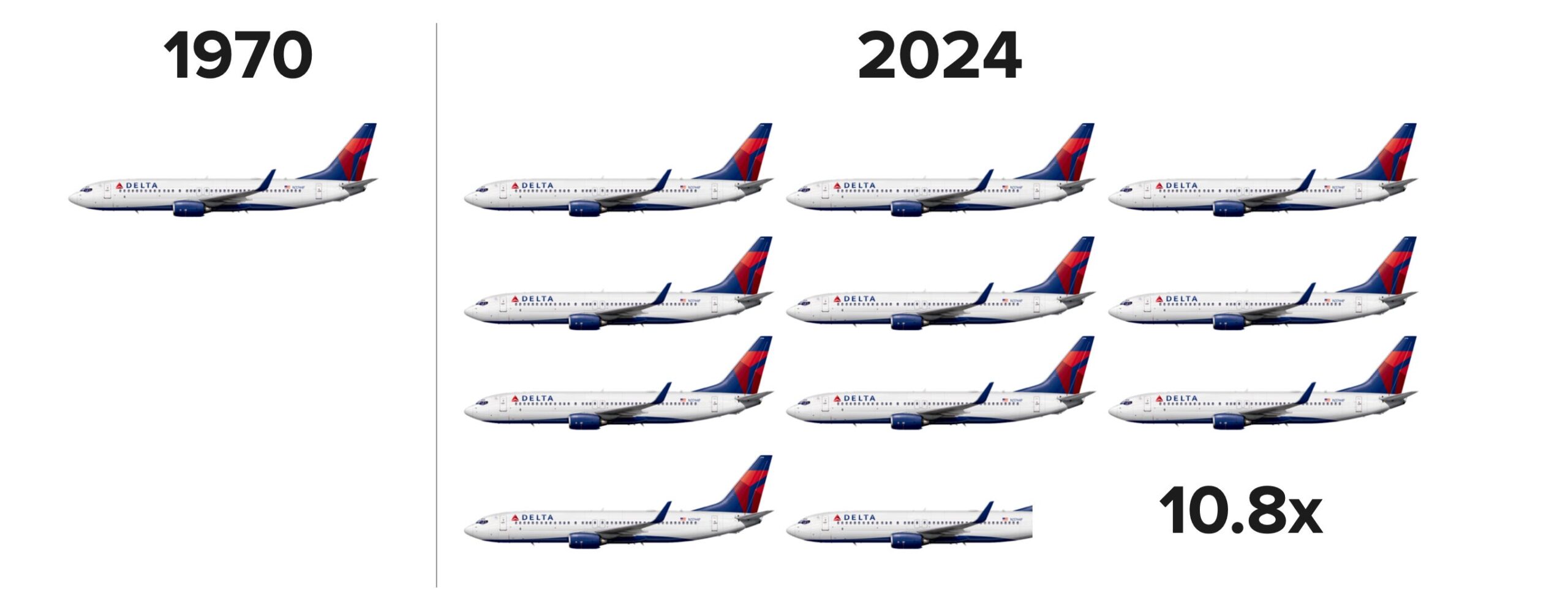The Duke of Wellington was said to have opposed the growth of railroads in 19th-century Britain because they would “only encourage the common people to move about needlessly.” Despite such elitist disdain for personal mobility—a disdain that persists today—railroads and later automobiles did catch on and greatly expanded humanity’s freedom to experience and gain benefit from the world beyond their local surroundings. This transportation revolution started in developed nations but has been expanding to developing ones.
One mode of transportation has been particularly slow to spread globally—air travel. But things are changing as incomes around the world rise to the point that many more people can afford an airline ticket. At the same time, inflation-adjusted air travel costs have trended lower. The construction of more airports in previously underserved nations has also played a role.
Air travel is likely to continue increasing in the decades ahead, particularly among citizens of poorer nations where air travel had long been out of reach for most. But there are potential headwinds in the form of climate policies that prioritize reducing aircraft emissions over affordability.
Air Travel Is a Global Growth Industry
The data tell a compelling story. Whether measured in terms of number of passengers or total miles flown, air travel has been increasing in recent decades (the sharp drop during the height of COVID-19 in 2020 and 2021 is presumed to be temporary). The first year in which two billion people took to the skies was 2004, but by 2019, the last full year before the pandemic, it had more than doubled to 4.6 billion. No other mode of transport has experienced such rapid growth.
The most striking trend is among the citizens of developing nations. For example, the number of Latin American passengers tripled from 1999 to 2019, and those from Congo and Bangladesh quadrupled. And there is still quite a lot of room on the upside.
The robust growth will very likely continue. According to the United Nation’s International Civil Aviation Organization (ICAO), air transport is projected to increase 4.3 percent per year over the next two decades, effectively doubling. The percentage growth of the airline industry is expected to be highest in developing nations.
Whereas past air travel growth included a substantial contribution from regular flyers from developed countries taking more frequent trips, future trends will primarily be driven by the many millions of new air passengers around the globe, including quite a few whose parents and grandparents never once set foot on a plane.
Climate Policy Takes Flight
These growth projections have not escaped the notice of policymakers focused on climate change. Aircraft engine emissions currently account for only about 3 percent of anthropogenic climate change (some other estimates are closer to 2 percent). This is mostly attributable to the carbon dioxide emissions from the combustion of aviation fuel; though, the contrails formed by aircraft at altitude are also a factor. Emissions are expected to rise along with increased passenger miles flown, though not by as much since new aircraft are expected to become more fuel-efficient over time.
The efficiency gains are driven by the market—fuel is the second-largest expense for commercial airlines, only behind labor costs, and fuel efficiency is a major factor in choosing which new aircraft to purchase. Aircraft manufacturers, for their part, must also prioritize fuel efficiency to remain competitive. Nonetheless, there is an aggressive push to force further efficiencies in the name of reducing greenhouse gas emissions.
In addition, sustainable aviation fuels, which are derived from agricultural or waste materials rather than petroleum, are also becoming a major tool the airline industry plans to use to reduce aviation’s greenhouse gas emissions. This assumes that using sustainable aviation fuels entails lower life-cycle greenhouse gas emissions than the equivalent amount of conventional aviation fuel they would displace. It should be noted, however, that similar efforts to promote advanced biofuels to displace petroleum-derived ground transportation fuels have largely met with failure, as the cost of these alternatives has remained well above that of conventional gasoline and diesel fuel. Even many environmentalists have come to question whether the claimed environmental benefits are real.
ICAO has adopted climate-related measures, including the long-term aspirational goal of net zero by 2050. More immediately, most ICAO member nations have agreed to participate in its Carbon Offsetting and Reduction Scheme for International Aviation (CORSIA). CORSIA sets 2019 as the baseline year for greenhouse gas emissions from international flights and requires a 15 percent reduction from that level beginning in 2024. Airlines can reduce their emissions by instituting fuel efficiency or other technological improvements, making operational improvements, or using sustainable aviation fuels. If these prove insufficient to meet their targets, airlines must acquire carbon offsets to make up for the shortfall. These offsets can be purchased from entities that have undertaken renewable energy, reforestation, or other approved projects. Developing nations face less stringent provisions under CORSIA.
At the national level, the U.S. Environmental Protection Agency (EPA) and several other governments are pursuing programs targeting aircraft emissions that generally track the stringency under CORSIA. In addition, the European Union has imposed an Emissions Trading System for aircraft emissions to align them with the overall targets under the Paris Agreement. France has already banned some short domestic flights where the government has determined that train travel is an adequate alternative.
What Will It Cost?
The costs of the climate agenda are hard to determine at this early stage, so it is not yet known how much will filter down to passengers in the form of higher ticket prices. One study on achieving net zero from aviation by 2050 puts the cost at $175 billion annually.
However, the future costs could be significantly higher given that none of the efforts imposed thus far have satisfied the environmental activist community. With few if any exceptions, they have decried CORSIA and similar national requirements as woefully inadequate and are demanding the screws be tightened. Predictably, several green groups are also questioning the claimed benefits of sustainable aviation fuels and consider their use by the airlines as nothing less than greenwashing.
In the United States, environmental groups sued EPA to set more stringent aircraft emissions controls. The litigation was unsuccessful, but these groups will continue to exert legal and political pressure to crack down on flying. For its part, the Biden administration has expressed sympathy for more stringent measures, both domestically and internationally.
It is worth noting that even very draconian and prohibitively costly measures are unlikely to change future temperatures very much. “Even if every single one of the 4.5 billion people getting on any flight this year stayed on the ground, and the same happened every year until 2100, the rise in temperatures would be reduced by just 0.05°F, equivalent to delaying climate change by less than one year in 2100,” says Bjorn Lomborg in False Alarm: How Climate Change Panic Costs Us Trillions, Hurts the Poor, and Fails to Fix the Planet.
Grounding Flyers from Developing Countries
What stands out in the ongoing debate is how little concern there is about the impact of climate measures on the affordability of flying and especially on air travel growth among citizens of developing nations. While some lament the potential end of cheap flights for first-world travelers, there is scant acknowledgement that costly climate policies could price millions of others out of the skies entirely.
Worse yet, more than a few climate change hard liners have admitted that greatly curtailing air travel is the only acceptable goal. Preserving the mobility gains of the less fortunate is not of concern to them, and in fact, developing nations come up only in the context of the perceived need to shield the poor from the damage done by flying. Others are questioning the morality of building more airports, which of course would disproportionately hamper nations that do not yet have adequate aviation infrastructure. It appears that the Duke of Wellington lives on in spirit.




